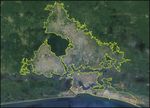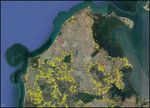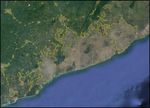Processing satellite images - Annexe A - OECD iLibrary
←
→
Page content transcription
If your browser does not render page correctly, please read the page content below
Annexe A Processing satellite images
Annexe A
Processing satellite images
The objective of this procedure is to replace the of points corresponding to the centroids of
manual digitisation of urban agglomerations agglomerations of more than 10 000 inhabitants,
carried out using Google Earth satellite images, so as to retain only the agglomerations targeted
which represent an incomparable source of very by Africapolis. The outlines of the agglomera-
high-resolution images for the entire African tions are shown in Images A.1 (“f”) and A.2 (“f”).
continent. A final visual check is made to correct any classi-
The procedure for extracting/identifying fication errors.
urban areas/surfaces is sub-divided into two The image processing sequence for wetlands
sequences: one which corresponds to dry zones follows the sequence outlined above with a few
(approximately 800 mm of precipitation per year) (Graph its environment makes it possible, in wetlands,
A.1). to use "high thresholding" on the grey-tinted
The images are initially (typical image size image ("b", Image A.2). The overlapping of the two
is 4 800 x 3 500 pixels) converted to grey-tinted binary masks ("d", Image A.2) makes it possible
images ("2a" and "3a", Figure A.1) and they are to extract the urban areas by applying a selec-
automatically georeferenced from the centre tion based on both the texture and the spectral
co-ordinates of the image and the co-ordinates response of the surfaces (the grey levels). Some
of the lower right-hand corner. The contrast misclassified areas of Lagos Lake were elimi-
between urban areas and their surroundings is nated using this process (yellow portions in "d",
enhanced using a method proposed by Mering et Image A.2). Finally, a specific algorithm is applied
al. (2010), which is based on the use of morpholo- which gathers all of the pixels that belong to one
gical filters. The combination of the “White Top agglomeration and that are located within 200
Hat” and “Black Top Hat” (“2b”) filters makes it metres of one another. The application of this
possible to extract the “salt and pepper” texture algorithm is particularly important in wetlands
which results from “the overlapping of light- where populations are often widely dispersed
ly-shaded buildings, of roads and of shadows ("f", Image A.2).
cast by dark-hued buildings” (Baro et al., 2014).
Subsequently, a closure by reconstruction is
made to smooth the images ("2c"). Finally, the
application of "high thresholding" makes it
possible to isolate urban areas in a binary mask
("2d" and "3c"). In a second phase, the images
undergo further processing to remove portions
of certain structures (from roads, rivers or
beaches) which might be misconstrued as urban
and which would therefore skew the estimation
of urban areas ("2e" and “3e "). Next, “holes” in
the images are filled and the final product is
cross-referenced against a vectoral database
130 AFRICA'S URBANISATION DYNAMICS 2020 © OECD 2020Processing satellite images Annexe A
Figure A.1
Image processing sequences (simplified)
Dry zones Wetlands
[ 2a ]
Grey tinted image White Top Hat Black Top Hat
[ 3a ]
Grey tinted image
[ 2b ] Closure by reconstruction
White Top Hat Black Top Hat
[ 3b ] [ 3c ]
High thresholding High thresholding
[ 2c ]
Closure by reconstruction
[ 3d ]
Overlapping
[ 2d ]
High thresholding
[ 3e ]
Filling of holes (by size)
[ 2e ]
Filling of holes (by size)
Gathering from
the rule of 200 m
Deletion of poorly classified pixels
Filling of holes (by size)
Overlapping with the
Geopolis agglomeration centroids [ 3f ]
Overlapping with the
Geopolis agglomeration centroids
[ 2f ]
Output polygones Output polygones
AFRICA'S URBANISATION DYNAMICS 2020 © OECD 2020 131Annexe A Processing satellite images
Image A.1
Image processing sequence (dry zone), Zinder (Niger)
a) b)
c) d)
e) f) Scale: 2 km
Notes: a) Original image in shades of grey; b) Application of morphological filters on the grey-tinted image. Sum of White Top Hat and Black Top Hat;
c) Closure by reconstruction of image “b”; d) Binary image obtained through the "high thresholding" of image "c"; e) Deletion of pixels that could be
misclassified; f) Final outline of the agglomeration after cross-referencing with the Geopolis database.
Source: Google Earth (accessed February 2018)
132 AFRICA'S URBANISATION DYNAMICS 2020 © OECD 2020Processing satellite images Annexe A Image A.2 Image processing sequence (wetlands), Lagos (Nigeria) a) b) c) d) e) f) Scale: 12 km Note: a) Original image in shades of grey; b) Binary mask obtained from the "high thresholding" of the grey-tinted image; c) Binary mask obtained from the "high thresholding" of the image to which morphological filters have been applied; d) Overlapping of “b” and “c”. The red corresponds to the parts that are perfectly overlapped, the yellow to portions only visible in image “b” and the blue to portions only visible in image “c”; e) Deletion of pixels that could be misclassified; f) Final outline of the agglomeration after cross-referencing with the Geopolis database. Source: Google Earth (accessed February 2018) AFRICA'S URBANISATION DYNAMICS 2020 © OECD 2020 133
Annexe A Processing satellite images
Image A.3
Wet zone agglomerations
a) Scale: 20 km b) Scale: 20 km
c) Scale: 10 km d) Scale: 20 km
e) Scale: 4 km f) Scale: 4 km
Note: a) Accra (Ghana), b) Kumassi (Ghana), c) Abidjan (Côte d’Ivoire), d) Onitsha (Nigeria), e) Ziguinchor (Senegal), f) Kenema (Sierra Leone).
Source: Google Earth (accessed February 2018)
134 AFRICA'S URBANISATION DYNAMICS 2020 © OECD 2020Processing satellite images Annexe A Image A.4 Dry zone agglomerations with exceptions a) Scale: 10 km b) Scale: 7 km c) Scale: 2 km d) Scale: 3 km e) Scale: 1,5 km f) Scale: 6 km Note: a) N’Djamena (Chad), b) Banjul (Gambia), c) Tambawel (Nigeria), d) Kaolack (Senegal), e) cluster of small urban agglomerations (Togo), f) cluster of small urban agglomerations (Nigeria). Source: Google Earth (accessed February 2018) AFRICA'S URBANISATION DYNAMICS 2020 © OECD 2020 135
From:
Africa's Urbanisation Dynamics 2020
Africapolis, Mapping a New Urban Geography
Access the complete publication at:
https://doi.org/10.1787/b6bccb81-en
Please cite this chapter as:
OECD/Sahel and West Africa Club (2020), “Processing satellite images”, in Africa's Urbanisation Dynamics
2020: Africapolis, Mapping a New Urban Geography, OECD Publishing, Paris.
DOI: https://doi.org/10.1787/7e740a18-en
This work is published under the responsibility of the Secretary-General of the OECD. The opinions expressed and arguments
employed herein do not necessarily reflect the official views of OECD member countries.
This document, as well as any data and map included herein, are without prejudice to the status of or sovereignty over any
territory, to the delimitation of international frontiers and boundaries and to the name of any territory, city or area. Extracts from
publications may be subject to additional disclaimers, which are set out in the complete version of the publication, available at
the link provided.
The use of this work, whether digital or print, is governed by the Terms and Conditions to be found at
http://www.oecd.org/termsandconditions.You can also read



























































